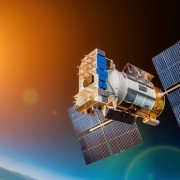How Today’s GPS Breakthroughs Were Brought To Us By A Dedicated 18C Clockmaker.
In the address line of this blogpost you see the Universal Resource Locator (URL). The device on which you are reading this article has its own Internet Protocol (IP) address on your local area network (LAN). And you can use your device to find your exact geographical location, almost instantly, using global positioning technology (GPS) software connected to a communications satellite in geosynchronous orbit (GEO) a few miles overhead.
While it’s only natural to take all of this for granted, it is also natural for Poetic Justice Warriors to ask, was it even possible to know my global address before all of these marvels that require electricity? The answer is no, except for a few decades immediately prior to electricity. And not only was it impossible, it posed the most important and perplexing scientific problem in the world for 1600 years. Something that could only be solved through reason applied to reality, by an inventor. By an entrepreneur.
A Perplexing Scientific Problem for the Ages
In 150 AD, a Greco-Roman mathematician and astronomer by the name of Ptolemy created the imaginary fabric that covers the globe. Like a fine cloth, the strands were precisely woven into a geometric grid. The lines of latitude that mark north and south are concentric circles, they never intersect, so the distance between one parallel circle and another never changes. The meridians of longitude that mark east and west are different, they intersect at the poles, meaning the space between them expands as they get closer to the equator.
Because the earth spins on its axis and faces the sun, it is natural to assign the equator as zero degrees latitude. For longitude, there is no naturally self-evident zero degree meridian. As such, assigning any meridian the zero degree starting point is purely arbitrary. And it eventually became a political issue. A much bigger difference is that while an experienced astronomer on land or navigator at sea could easily measure latitude based on celestial observations such as the Sun and the North Star, measuring longitude by the stars was impossible. One reason for that may be that angles of longitude are measured from the center of the earth.
Because of the lives and treasure lost over many centuries, merchant ships, explorers, and navies were desperate to find a solution to the problem of longitude. Without land based markers, they never knew precisely where they were, and too much of the time they were lost. For example, Ferdinand Magellan’s scribe Pigafetta reported, “The captain spends many hours studying the problem of the longitude but the pilots content themselves with the knowledge of the latitude.”
Bureaucracies and the Mechanical GPS
In 1714, 200 years after Magellan and 1600 years after Ptolemy, the British Parliament passed the Longitude Act and funded a $2.9 million prize (in today’s dollars) for a reliable and repeatable solution. And while this created additional incentives for scientists and inventors, it also created another obstacle – politics and bureaucracy. Certain academic elites were determined to discover the celestial clock that would earn them the prize, but a mechanical clock won the millennium.
The challenge was to devise an extremely accurate and reliable timepiece, especially under conditions of wild temperature and humidity changes, and the roiling of the sea. When elapsed time was combined with changes in latitude derived by celestial means, longitude could be calculated. Such a clock would be central to humanity’s first global positioning system (GPS).
Its inventor was the watchmaker, carpenter, and choirmaster John Harrison. According to Dava Sobel in her book Longitude, Harrison was “a mechanical genius with no formal education or apprenticeship to any watchmaker, he nevertheless constructed a series of virtually friction-free clocks that required no lubrication or cleaning, made from materials impervious to rust.” Not only did Harrison invest 40 years of his life in the problem, submitting the first of five prototypes in 1730, there was significant skepticism that delayed Harrison’s award. As Sobel describes,
In 1773, John Harrison finally collected his prize, despite decades of political intrigue, the backbiting of academic elites, and scientific revolution. With his marine clocks, John Harrison tested the waters of space-time. He succeeded against all odds, in using the fourth dimension to link points on the three dimensional globe. He wrested the world’s whereabouts from the stars, and locked the secret in a pocket watch.
The Prime Meridian, which has been firmly established as zero degrees longitude, is located in Greenwich, England. Specifically, it runs directly through the Flamsteed House. It was by commissioned by King Charles II in 1675 to be a celestial observatory, and its purpose was to “find out the so-much desired longitude at sea for perfecting the art of navigation.” The observatory is now the home of John Harrison’s prototype maritime clocks. According to astronaut Neil Armstrong, “It is ironic that the clocks, at the time of this writing, should reside in the laboratory of the clock’s greatest critics. The astronomers.” Poetic justice served.
Standing on the Shoulders of Giants
John Harrison died three years after being officially recognized for his achievement, but the prize itself was merely symbolic of something more personally satisfying. As Sobel explains, “for decades he had stood apart, virtually alone, as the only person in the world seriously pursuing a timekeeper solution to the longitude problem.” Utilizing his capacity for reason, and combining it with a life of purpose, he could say with pride, it’s mine. But was it? Like any life-fulfilling invention released into a capitalist system, the value it creates expands exponentially and cannot be measured.
In the aftermath of Harrison’s success, legions of watchmakers joined in the new boom industry of maritime timepieces; creating more, and better, and cheaper product. It’s Say’s Law: producers create consumers. Then producers become the consumers created by other producers. Its a beautiful thing, so says Say.
And what a marvelous example of the spontaneous order of poetic justice. Harrison’s chronometer was essential to the expansion of international trade throughout the 19th century, and contributed mightily to its life-changing economic and technological achievements. Lower transportation risks leads to lower prices, more production, more consumers, greater wealth, and a higher quality of life spread far and wide. This breeds more capital accumulation, new technology, flourishing arts, and leisure time to sit around coffee houses connected to a GEO through a LAN while reading this URL on your IP address, and asking – how can I be a PJW?





